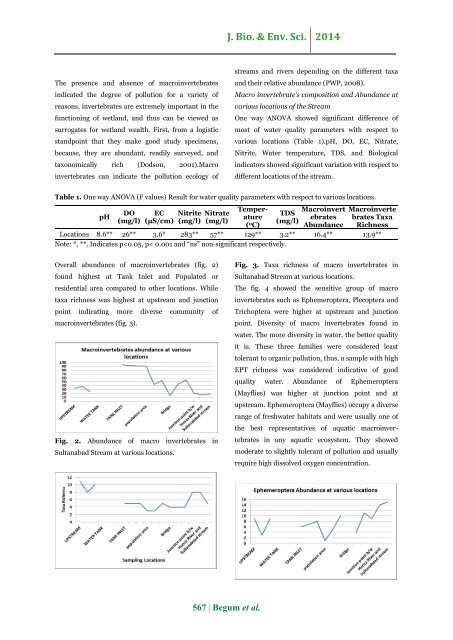Water quality assessment using macroinvertebrates as indicator in sultanabad stream (Nallah), Gilgit, Gilgit-Baltistan, Pakistan
Abstract This preliminary research was to evaluate the water quality assessment through macro invertebrates and selected physio-chemical parameters in Sultanabad Stream (Nallah in Urdu). Samples were collected from six different locations started from upstream to the downstream of the Stream (Nallah). Sampling was done using standard methods such as Macroinvertebrates collection through Kick net having 500um mesh size and selected physio-chemical parameters such as dissolved oxygen (DO), Total Dissolved Solids (TDS), temperature and pH. Most of the physio-chemical parameters were measured using multi parameter probe at the sampling occasion except Electrical Conductivity (EC), Nitrites and Nitrates which were measured using Conductivity meter and nitrate strips in the laboratory respectively. A total of 718 macro invertebrates were recorded comprising of Chironomidae (Diptera) (78%) being most dominant group, Ephemeroptera (17%), Plecoptera (4%) and Trichoptera (1%). Sensitive group of macro invertebrates like Ephemeroptera, Trichoptera and Plecoptera were abundant at upstream and at junction point as compare to other locations of the Stream, indicating good water quality at upstream. One way ANOVA showed significant difference of most of water quality parameters with respect to various locations. Result of overall mean physio-chemical properties of the stream were like alkaline pH (7.4), low temperature ( 8.9 oC), high DO (10 mg/l ), low TDS (284.4 mg/l ), low nitrites ( 0.88 mg/l) and nitrates (8.8 mg/l) and low EC ( 467 μS/cm).
Abstract
This preliminary research was to evaluate the water quality assessment through macro invertebrates and selected physio-chemical parameters in Sultanabad Stream (Nallah in Urdu). Samples were collected from six different locations started from upstream to the downstream of the Stream (Nallah). Sampling was done using standard methods such as Macroinvertebrates collection through Kick net having 500um mesh size and selected physio-chemical parameters such as dissolved oxygen (DO), Total Dissolved Solids (TDS), temperature and pH. Most of the physio-chemical parameters were measured using multi parameter probe at the sampling occasion except Electrical Conductivity (EC), Nitrites and Nitrates which were measured using Conductivity meter and nitrate strips in the laboratory respectively. A total of 718 macro invertebrates were recorded comprising of Chironomidae (Diptera) (78%) being most dominant group, Ephemeroptera (17%), Plecoptera (4%) and Trichoptera (1%). Sensitive group of macro invertebrates like Ephemeroptera, Trichoptera and Plecoptera were abundant at upstream and at junction point as compare to other locations of the Stream, indicating good water quality at upstream. One way ANOVA showed significant difference of most of water quality parameters with respect to various locations. Result of overall mean physio-chemical properties of the stream were like alkaline pH (7.4), low temperature ( 8.9 oC), high DO (10 mg/l ), low TDS (284.4 mg/l ), low nitrites ( 0.88 mg/l) and nitrates (8.8 mg/l) and low EC ( 467 μS/cm).
Create successful ePaper yourself
Turn your PDF publications into a flip-book with our unique Google optimized e-Paper software.
J. Bio. & Env. Sci. 2014<br />
The presence and absence of <strong>macro<strong>in</strong>vertebrates</strong><br />
<strong>in</strong>dicated the degree of pollution for a variety of<br />
re<strong>as</strong>ons, <strong>in</strong>vertebrates are extremely important <strong>in</strong> the<br />
function<strong>in</strong>g of wetland, and thus can be viewed <strong>as</strong><br />
surrogates for wetland wealth. First, from a logistic<br />
standpo<strong>in</strong>t that they make good study specimens,<br />
because, they are abundant, readily surveyed, and<br />
taxonomically rich (Dodson, 2001).Macro<br />
<strong>in</strong>vertebrates can <strong>in</strong>dicate the pollution ecology of<br />
<strong>stream</strong>s and rivers depend<strong>in</strong>g on the different taxa<br />
and their relative abundance (PWP, 2008).<br />
Macro <strong>in</strong>vertebrate’s composition and Abundance at<br />
various locations of the Stream<br />
One way ANOVA showed significant difference of<br />
most of water <strong>quality</strong> parameters with respect to<br />
various locations (Table 1).pH, DO, EC, Nitrate,<br />
Nitrite, <strong>Water</strong> temperature, TDS, and Biological<br />
<strong><strong>in</strong>dicator</strong>s showed significant variation with respect to<br />
different locations of the <strong>stream</strong>.<br />
Table 1. One way ANOVA (F values) Result for water <strong>quality</strong> parameters with respect to various locations.<br />
pH<br />
DO<br />
(mg/l)<br />
EC<br />
(µS/cm)<br />
Nitrite<br />
(mg/l)<br />
Nitrate<br />
(mg/l)<br />
Temperature<br />
( o C)<br />
Macro<strong>in</strong>vert<br />
TDS<br />
ebrates<br />
(mg/l)<br />
Abundance<br />
Macro<strong>in</strong>verte<br />
brates Taxa<br />
Richness<br />
Locations 8.6** 26** 3.6* 283** 57** 129** 3.2** 16.4** 13.9**<br />
Note: *, **, Indicates p





![Review on: impact of seed rates and method of sowing on yield and yield related traits of Teff [Eragrostis teff (Zucc.) Trotter] | IJAAR @yumpu](https://documents.yumpu.com/000/066/025/853/c0a2f1eefa2ed71422e741fbc2b37a5fd6200cb1/6b7767675149533469736965546e4c6a4e57325054773d3d/4f6e6531383245617a537a49397878747846574858513d3d.jpg?AWSAccessKeyId=AKIAICNEWSPSEKTJ5M3Q&Expires=1714806000&Signature=cu61UgyCoc7lMNHe68epkGprFnE%3D)












